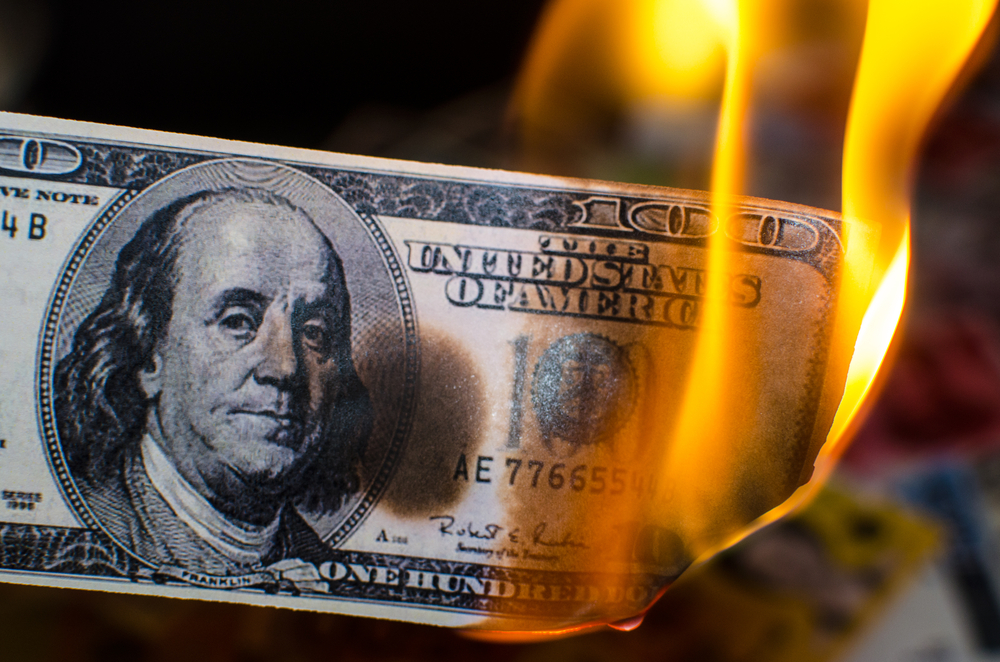The Fed Lights the World on Fire
Andy Snyder|March 18, 2021

Here’s an irritating fact for you…
We often talk about the compounding power of interest, but what about the compounding power of inflation?
The numbers aren’t good.
Even at the Fed’s so-called “Goldilocks” goal that has prices moving higher by 2% each year, the purchasing power of a dollar today drops to $0.82 in a decade… goes to $0.67 in 20 years and is slashed nearly in half (to $0.55) in 30 years.
And that’s if inflation stops at the Fed’s goal. The bank of banks has already said many times over the last 12 months that it will allow prices to rise even faster in coming months.
Clearly, if the Fed gets its way, many Americans will get poorer.
Lighting a Fire
So why in the world do Jay Powell and his banking cronies want inflation to rise so darn badly?
Like lighting a forest on fire to get rid of the weak and the invasives, the intent is good. Trouble brews only when humans and their innovations get in the way.
There are two main reasons the Fed wants inflation.
The first is a reason we’re sure you are quite familiar with these days – falling prices. According to the Fed… they’re bad.
The theory says that if we believe a price will be lower in a month, we’ll wait a month or perhaps a year to buy it.
That’s bad news for carmakers, factories and even real estate investors.
During the Great Depression, the idea led to what we economic thinkers call a “death spiral.”
Folks stopped buying stuff, so factories stopped making stuff. Jobs were lost, demand plunged and prices went even lower. Eventually it spiraled out of control.
We agree the Fed should work to avoid such things.
But, as we’ve so often told our Manward Letter readers, not all falling prices are bad. Plus, there are many ways you can win (quite handsomely) when prices fall.
Sure, folks won’t buy new cars when they think they can save a few grand next month. But they’ll still buy food… go to casinos… renew their Netflix subscriptions… and toss out their old phones if the new one promises more features.
Over the last decade, deflationary pressure has been at some of the highest levels of our lifetimes. And guess what? The sectors represented above have treated investors quite well.
Don’t tell the Fed… or his friends at the IRS.
Cutting What We Owe
The second reason the Fed needs rising prices is perhaps the most potent… and scary.
We are a nation built on debt.
The nation’s consumer debt stands at $14.2 trillion… with the average American owing more than $97,000.
Our corporate debt is $1.5 trillion (up thirtyfold from 50 years ago!).
And, of course, our national debt can’t be figured by most calculators. It’s up to $28 trillion – twice the debt of all the companies that truly make the economy move forward.
Paying back that much debt is hard enough. It’s even tougher when prices are falling and dollars are getting harder to find.
Going back to those figures from the very top, we can see why folks say inflation is good.
The average mortgage in this country puts the homeowner on the hook for 30 years. With modest inflation, it can be quite a good deal.
At first, the monthly tab seems stiff. We’re paying in today’s dollars.
In a decade, though, inflation will cut away at the purchasing power of our cash. The real value of our monthly payment (in terms of purchasing power) will be just 82% of what it was when the loan was first written.
It will be like we’re getting an 18% discount each month.
By the end of the term, oh boy, the monthly payments will be easy to cover. By then we’ll be getting a 45% discount. Our thousand-bucks-a-month payment used to buy a round-trip ticket to Paris. But by the end of our 30-year mortgage, it’ll scarcely buy us a one-way bus ticket to Detroit.
That’s good news for the average citizen and his $208,000 mortgage (a figure that, to the Fed’s delight, rose by 2% last year). It’s even greater news for the Treasury, which is on the hook for a whole lot more.
With each passing day, it seems more and more intent on inflating away its debt woes.
It has no other choice.
The Problem
Again, there are some very big caveats to all this.
The big one… is the one that keeps folks on a fixed income up at night.
The Fed assumes incomes will rise alongside inflation. For the most part, the idea is true. But for folks at the bottom end of the socioeconomic scale, inflation is hardly good news. Their wages won’t rise fast enough. And the faster money loses its value, the further up the scale trouble climbs.
There are two ways to avoid the problem.
The first feeds right into Washington’s goals. It’s a solution you likely don’t want to hear… but should.
It’s debt.
When inflation takes hold, debt (in moderation, of course) is your friend. It may be emotionally tempting to have a pile of cash in the bank. But it will cost you. Again, at an inflation rate of 2% per year… your $200,000 tucked safely in the bank might buy a decent house today but will buy you a much smaller place in a decade. In 30 years, it will hardly be a down payment.
It goes against the conventional wisdom to recommend debt… but, done right, it’s the smartest path to take.
The second option is much more palatable but much harder to put to use.
You must increase your income to match the pace of inflation.
If you’re employed and inflation stays moderate, it’s not all that tough, especially if you follow a prudent budget.
But if you’re on a fixed income, oh boy, things get tougher.
It’s why it’s so important to be an informed and active investor. The traditional 60-40 portfolio that’s been the mainstay of financial management is bunk. It’ll beat cash in the bank but not by much… certainly not by enough to beat the coming inflationary surge.
And when it comes… you’ll have the unelected folks at the Fed to thank.
At least now you’ll know why they made it happen.
They’re just trying to light the world on fire.
Please don’t get in the way.
Editor’s Note: As Andy said… it’s never been more important to be an investor. And our friends at Monument Traders Alliance agree. The Fed’s actions are leading to what they’re calling the “Great Stockflation.” Stocks are going to rise faster than they ever have before. If you want to grow your money… are sitting in cash… or are worried about inflation… then you need to watch this ASAP.
Would you take on more debt to protect your assets from inflation? Let us know your thoughts at mailbag@manwardpress.com.






